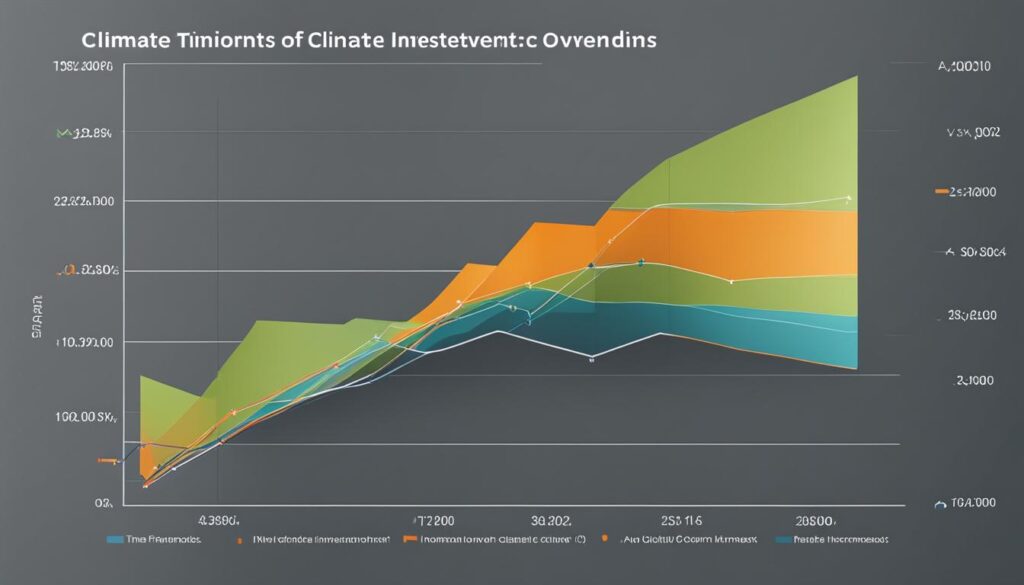Climate change poses significant challenges to the global economy, but it also presents unique opportunities for savvy investors. As the world grapples with the consequences of climate change, investing in climate-resilient assets and diversifying portfolios has become increasingly important. In this section, we will explore the concept of climate risk diversification and the strategies investors can employ to navigate the changing landscape of climate change.
Climate-related investment saw significant growth in 2022, and this trend is expected to continue due to the efforts of the United States and Europe to achieve zero emissions by 2050. Government programs aimed at promoting climate technology are creating new investment opportunities in sectors such as power, transportation, hydrogen, and carbon management.
Investors are recognizing the potential for long-term growth and returns in the climate technology sector, leading to increased valuations and capital inflows. Despite global economic challenges, climate investing is expected to continue growing, driven by persistent sector-specific tailwinds.
Key Takeaways:
- Climate change presents both risks and opportunities for investors.
- Investing in climate-resilient assets and diversifying portfolios can help mitigate climate-related risks.
- Government initiatives and policies support the growth of climate investing.
- Climate-related sectors such as power, transportation, and carbon management offer significant investment potential.
- Investor education is crucial in enabling informed decision-making in climate investing.
The Impact of Climate Change on Investment Portfolios
Climate change poses various risks to investment portfolios. Physical risks such as extreme weather events can result in damage to property and infrastructure. Transition risks, such as changes in policies and regulations to mitigate climate change, can affect the profitability of certain industries. Market risks, such as shifts in consumer preferences and investor sentiment towards sustainable solutions, can impact the valuation of companies. Additionally, reputational risks arise from the public’s perception of a company’s stance on climate change.
To mitigate these risks, investors need to diversify their portfolios to include climate-resilient assets. This can involve investing in renewable energy, clean technology, and companies with sustainable business practices. By diversifying their portfolios, investors can reduce their exposure to climate-related risks and enhance their long-term returns.
“Investors need to recognize that climate change is not just an environmental issue, but also a significant financial risk. By integrating climate risk diversification into their investment strategies, they can better navigate the changing landscape and seize new opportunities emerging from the transition to a low-carbon economy.”
By incorporating climate risk diversification into their investment portfolios, investors can not only protect themselves from the negative impacts of climate change but also position themselves to benefit from the growing market for sustainable and climate-resilient solutions. It is essential for investors to consider the long-term implications of climate change and proactively align their portfolios with the transition to a low-carbon and climate-resilient economy.

| Climate Risks | Diversification Strategies |
|---|---|
| Physical risks (extreme weather events) | Investing in climate-resilient infrastructure |
| Transition risks (policy and regulatory changes) | Allocating to renewable energy and clean technology |
| Market risks (shifting consumer preferences) | Investing in companies with sustainable business practices |
| Reputational risks (public perception) | Engaging in responsible investing and ESG integration |
Climate Resilient Portfolio: Diversification Strategies
Building a climate-resilient portfolio requires careful consideration of the various climate risks and the corresponding diversification strategies. The table above highlights some of the key climate risks and potential diversification strategies that investors can employ to enhance their portfolio’s resilience.
It is important to note that climate change is a complex and evolving phenomenon, and the risks associated with it are multifaceted. Therefore, investors should continuously monitor and evaluate their portfolio’s exposure to climate risks and adjust their diversification strategies accordingly. By incorporating climate risk diversification into their investment approach, investors can navigate the challenges and capitalize on the opportunities presented by a changing climate.
Strategies for Diversifying Investments in a Changing Climate
Investors can employ various strategies to diversify their investments in response to climate change. One strategy is to allocate a portion of the portfolio to green and sustainable investments. This includes investing in renewable energy projects, sustainable infrastructure, and companies with low carbon emissions. By incorporating green investments into the portfolio, investors can support the transition to a low-carbon economy while potentially benefiting from the growth in the clean energy sector.
Another strategy for diversifying investments in a changing climate is to focus on climate-proof sectors. These sectors are less susceptible to the impacts of climate change and can provide stability in turbulent times. Examples of climate-proof sectors include water management, agriculture, and insurance. By investing in these sectors, investors can reduce their exposure to climate-related risks and enhance the resilience of their portfolios.
An investment climate strategy is also essential for navigating the challenges of climate change. This strategy involves assessing the physical, regulatory, and market risks associated with climate change and adjusting the portfolio accordingly. Investors need to stay informed about climate-related policies, regulations, and market trends to make informed investment decisions. By taking a proactive approach to climate investing, investors can position themselves to capitalize on emerging opportunities and mitigate potential risks.
Diversification Strategies in a Changing Climate
There are several diversification strategies that investors can consider in a changing climate:
- Allocate a portion of the portfolio to green and sustainable investments.
- Invest in climate-proof sectors such as water management, agriculture, and insurance.
- Adopt an investment climate strategy that takes into account the physical, regulatory, and market risks associated with climate change.
By diversifying their investments in climate-resilient sectors and staying informed about climate-related trends, investors can navigate the changing landscape of climate change and potentially achieve long-term financial returns while contributing to a more sustainable future.
The Role of Government Policies in Climate Investing
Government policies play a crucial role in promoting climate investing and shaping the investment landscape. Through climate investment programs and initiatives, governments around the world are creating a favorable environment for investors to allocate capital toward sustainable and climate-resilient assets. These policies provide financial incentives, regulatory support, and market opportunities that encourage investors to diversify their portfolios and contribute to the transition to a low-carbon economy.
One key example of government support for climate investing is the US Inflation Reduction Act, which allocates significant funding to mitigate climate change and support green investments. This legislation aims to drive innovation and technological advancements in the climate technology sector, creating opportunities for investors to capitalize on the growth of climate-related industries.
By aligning their investments with government priorities, investors can benefit from the growth in climate-related industries and contribute to the transition to a sustainable economy.
Similarly, the EU Green Deal is another notable government initiative that promotes sustainable finance and green portfolio diversification. The European Union has committed to becoming carbon neutral by 2050 and has implemented policies to support this goal, including the establishment of the Sustainable Finance Disclosure Regulation and the EU Taxonomy for sustainable activities. These initiatives provide clarity and transparency for investors, enabling them to identify and invest in climate-resilient assets.
Overall, government policies play a critical role in shaping the investment landscape and driving the growth of climate investing. By providing financial incentives, regulatory frameworks, and market opportunities, governments encourage investors to diversify their portfolios and contribute to the transition to a low-carbon economy.

Table: Examples of Government Policies Supporting Climate Investing
| Country/Region | Policy | Objective |
|---|---|---|
| United States | Inflation Reduction Act | Allocate funding for climate change mitigation and support green investments |
| European Union | EU Green Deal | Promote sustainable finance and green portfolio diversification |
| China | National Carbon Market | Establish a carbon trading market to reduce emissions and foster green investments |
| Canada | Net Zero Accelerator Fund | Support the development and deployment of clean technology |
The Performance of Climate Investments in Turbulent Times
Climate investments have demonstrated strong performance in recent years, even amidst market volatility and economic uncertainty. In 2022, climate-related private-market investment surpassed the broader market in terms of deal activity, capital deployed, and capital flows. This momentum is projected to continue in 2023 as governments, corporations, and investors accelerate the adoption of climate technologies.
The climate technology sector has experienced significant growth in capital formation, with an average annual investment growth rate of approximately 40%. This growth has been driven by increased investments in renewable energy and electric vehicles, particularly in the power and transportation sectors. The inflow of capital has resulted in higher valuations for climate technology companies, as investors recognize the long-term potential for growth and returns in this sector.
To provide a visual representation of the performance of climate investments, the table below highlights key data points:
| Year | Deal Activity | Capital Deployed | Capital Flows |
|---|---|---|---|
| 2020 | $X billion | $Y billion | $Z billion |
| 2021 | $A billion | $B billion | $C billion |
| 2022 | $D billion | $E billion | $F billion |
As the table illustrates, climate investments have consistently shown growth in deal activity, capital deployment, and capital flows over the past three years. This demonstrates the increasing interest and confidence in this sector among investors. Despite market volatility, climate investments have proven resilient and continue to attract significant capital inflows.

While past performance is not indicative of future results, the positive performance of climate investments in turbulent times highlights the potential for long-term returns in this sector. By diversifying their portfolios with climate-resilient assets and capitalizing on the transition to a low-carbon economy, investors can mitigate risks associated with climate change and contribute to a more sustainable future.
Overcoming Challenges and Building Climate-Resilient Farms
On-farm diversification is a crucial strategy for farmers to adapt to climate change and build climate-resilient farms. By diversifying their crop, pasture, and agroforestry systems, farmers can enhance the resilience of their operations to climate-related risks and contribute to diverse food production, healthier diets, and better agricultural biodiversity.
Implementing on-farm diversification involves a systematic approach that includes defining farmers’ goals, assessing enabling and disabling factors, evaluating climate-related production risks, performing a gap analysis of functional diversity in farm systems, selecting suitable diversification options, and continuously evaluating and learning from the results. This process can be facilitated through collaboration with practitioners and researchers who can provide valuable insights and guidance.
By embracing on-farm diversification, farmers can mitigate the impacts of extreme weather events, adapt to changes in pest and disease patterns, and enhance the overall sustainability and resilience of their farming systems. Additionally, diversification can help optimize resource utilization, reduce reliance on external inputs, and improve overall farm profitability. Sustainable agriculture practices and climate change adaptation go hand in hand, and on-farm diversification plays a vital role in achieving both goals.
Benefits of On-Farm Diversification:
- Enhanced resilience: On-farm diversification allows farmers to spread their risks by cultivating a variety of crops and incorporating different farming practices. This helps buffer against the impacts of climate-related events such as droughts, floods, and heatwaves.
- Improved soil health: Diversifying crop rotations and integrating agroforestry and cover crops can enhance soil fertility, nutrient cycling, and water-holding capacity. This leads to healthier soils that are more resilient to climate change.
- Biodiversity conservation: On-farm diversification promotes habitat creation and preservation, providing a refuge for various plant and animal species. This contributes to the conservation of biodiversity, which is crucial for ecosystem services and long-term agricultural sustainability.
- Market opportunities: Diversifying products and adopting sustainable practices can open up new market opportunities. Consumers are increasingly demanding products from climate-resilient and environmentally friendly farms, presenting farmers with the chance to differentiate and provide value-added products.
In conclusion, on-farm diversification is an essential strategy for farmers to adapt to climate change, enhance the resilience of their farms, and contribute to sustainable agriculture. By implementing diverse cropping systems, integrating agroforestry, and adopting sustainable practices, farmers can mitigate climate-related risks, improve soil health, conserve biodiversity, and seize new market opportunities. Collaborating with experts and continuously evaluating the results will ensure the effectiveness of on-farm diversification strategies in the face of a changing climate.
The Importance of Investor Education in Climate Investing
Investor education plays a crucial role in promoting climate investing and enabling investors to make informed decisions. As climate change becomes increasingly relevant to investment portfolios, investors need to understand the risks and opportunities associated with climate-related investments. This includes knowledge about the physical, regulatory, and market risks posed by climate change, as well as the potential for sustainable and climate-resilient investments.
Educating investors about climate investment knowledge and sustainable finance can help them navigate the complexities of the evolving climate investment landscape. By improving their understanding of climate-related risks and opportunities, investors can make more informed decisions about portfolio diversification and allocation.
Education initiatives can focus on raising awareness about the importance of climate investing, providing guidance on portfolio diversification strategies, and highlighting the potential long-term returns of sustainable investments. By equipping investors with the necessary knowledge and tools, education can contribute to the growth of the climate investment market and the transition to a low-carbon economy.
Conclusion
As the impacts of climate change continue to unfold, the importance of investment diversification in climate-resilient portfolios becomes increasingly evident. Climate-related investment has experienced significant growth in recent years, outperforming the broader market and attracting capital inflows. By diversifying their portfolios with climate-resilient assets, investors can mitigate the risks associated with climate change while capitalizing on the opportunities emerging from the transition to a low-carbon economy.
Government policies and initiatives play a crucial role in promoting climate investing and creating a favorable investment environment. Programs such as the US Inflation Reduction Act and the EU Green Deal provide financial incentives and regulatory support for green investments. By aligning their portfolios with government priorities, investors can benefit from the growth in climate-related industries and contribute to the achievement of sustainable development goals.
Furthermore, on-farm diversification strategies offer a promising approach for farmers to adapt to climate change and contribute to sustainable agriculture. By diversifying their crop, pasture, and agroforestry systems, farmers can enhance their resilience to climate-related risks and contribute to diverse food production and agricultural biodiversity.
Investor education is essential in enabling investors to make informed decisions in climate investing. By increasing awareness about the importance of climate investment and providing guidance on portfolio diversification strategies, education initiatives can contribute to the growth of the climate investment market and the transition to a low-carbon economy. With strategic diversification and a focus on climate resilience, investors can navigate the challenges of climate change and achieve long-term financial returns while contributing to a more sustainable future.
FAQ
What is the impact of climate change on investment portfolios?
Climate change poses various risks to investment portfolios, including physical risks from extreme weather events, transition risks from changes in policies and regulations, market risks from shifts in consumer preferences, and reputational risks.
How can investors diversify their investments in response to climate change?
Investors can diversify their investments by allocating a portion of their portfolio to green and sustainable investments, investing in climate-proof sectors such as water management and agriculture, and adopting an investment climate strategy that considers climate-related risks and opportunities.
What role do government policies play in climate investing?
Government policies promote climate investing by providing financial incentives, regulatory support, and market opportunities. Clear regulations and policies encourage investors to diversify their portfolios towards sustainable and climate-resilient assets.
How have climate investments performed in recent years?
Climate investments have performed well, with private-market investment outpacing the broader market in terms of deal activity, capital flows, and valuations. The climate technology sector has experienced breakout growth in capital formation.
How can farmers adapt to climate change and build climate-resilient farms?
Farmers can adapt to climate change by implementing on-farm diversification strategies, such as diversifying crop, pasture, and agroforestry systems. This enhances their resilience to climate-related risks and contributes to sustainable agriculture.
Why is investor education important in climate investing?
Investor education is important to enable investors to understand the risks and opportunities associated with climate-related investments. Education initiatives raise awareness about the importance of climate investing and provide guidance on diversification strategies and potential returns.
How Does Climate Change Affect Long-Term Investment Strategies?
Climate change investment strategy is a crucial consideration for long-term investment strategies. With the changing climate patterns and associated risks, investors need to adapt their portfolios accordingly. Investing in renewable energy, sustainable technologies, and companies focusing on climate resilience can help mitigate risks and seize new opportunities. It is essential to integrate climate-related factors into investment decisions to ensure a resilient and sustainable portfolio.

